The Mid Wales Geology Club (project leader: Colin Humphrey), in association with the Central Wales RIGS Group (chairman: Prof Bill Fitches), carried out a walkover survey of the landslide in Banc Dolhelfa in April 2010.
The summary information for this landslide case study has been taken entirely from Welsh RIGS report 578 and is not the work of BGS.
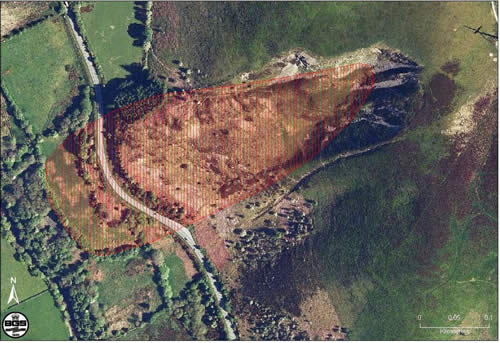
Aerial photograph of the Banc Dolhefa landslide. Red hashing denotes extent of BGS-mapped landslide deposit. BGS © UKRI.
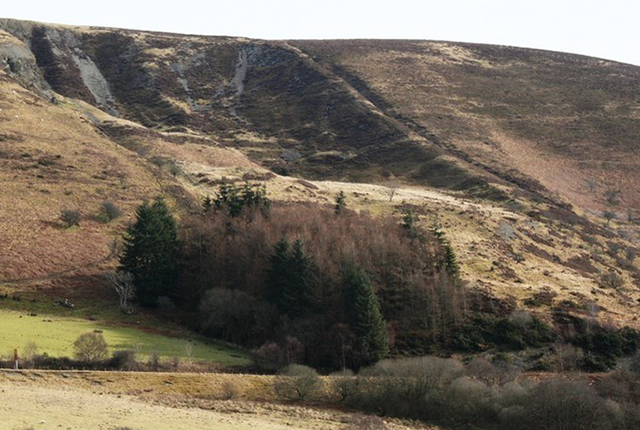
The Banc Dolhefa landslide. (Photograph courtesy of C Humphrey, Mid Wales Geology Club.)
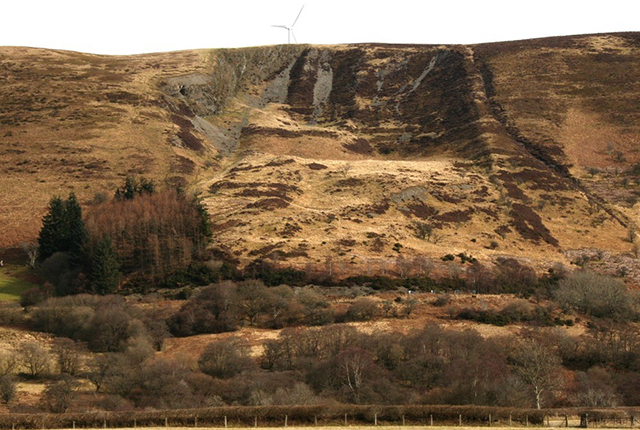
The Banc Dolhefa landslide taken from the toe of the landslide. (Photograph courtesy of C Humphrey, Mid Wales Geology Club.)
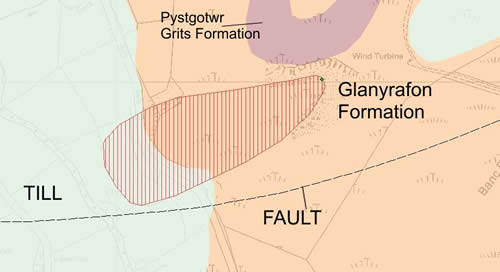
Geology map of the Banc Dolhelfa landslide. Red hashed area is the landslide deposit. Green dot is the location of National Landslide Database record for this event. © Crown Copyright.
The landslide
The Banc Dolhefa landslide (BGS National Landslide Database ID 11853/1) is about 5 km south of Llangurig in Mid Wales and is one of the largest bedrock slides in Mid Wales. The landslide is 650 m long and 150–200 m wide, calculated to have displaced around one third of a million cubic metres of rock. It is currently inactive, but a falling block was reported in 1850.
This is a complex landslide, predominantly translational in nature, with evidence of planar rock and debris sliding on the south side of the depletion zone and block failure by falling on the north side.
Failed rock on both sides broke into a debris flow in the accumulation zone. Evidently the south side slid on bedding planes partly concordant with the topographic slope and the back and north side failed on subvertical joints, leaving a steep escarpment. Subsequent progressive failure and retreat of the escarpment has occurred by slumping and rock fall.
Superficial deposits landslides
Most landslides in the area are in superficial deposits, but here the Silurian bedrock itself has failed. The trigger for the original failure is thought to be post-glacial movement on the visible fault parallel to the upper south edge. Subsequently, there has been some further collapse and retreat of parts of the northern escarpment. Scree deposits show that weathering and rock displacement has continued from the upper part of the slide in recent times.
Geology
The geology associated with this landslide is the Glanyrafon Formation, which comprises interbedded mudstones and sandstones that are approximately 430 million years old. The lower slopes of the landslide are covered with Devensian-aged till. There is a steeply dipping, east–north-east-striking fault very close to the southern flank of the landslide, passing beneath it at depth. The Pysgotwr Grits Formation is to the north and not incorporated into the landslide.
Note on the mapped landslide extent
The red hashed area is the landslide deposit as published by BGS, although the more recent detailed work in the RIGS report shows the deposit to be larger and more rectangular, with the south flank running parallel to the fault and the slide mass extending to the River Wye at the toe.
As with all BGS landslide maps, only the deposit is shown and the backscarp of this landslide can be seen above the deposit where the underlying Ordnance Survey map highlights a scarp slope where the Pystgotwr Grit Formation crops out.
Visiting the site
Banc Dolhefa is an excellent, clearly visible example of a complex landslide in bedrock and is of amateur and undergraduate geological and geomorphological interest. On-site, there are features that offer an opportunity for wide-ranging technical discussion of failure mechanisms.
An alternative to visiting the site itself is, for small groups, to view it from across the Wye valley, especially from SN 914 748, although parking is unsuitable for large vehicles. No rights of way exist over or near the landslide; many parts are dangerously steep and there is also a risk of rock fall.
Reference
Humphrey, C. 2012. The Landslide at Banc Dolhelfa, near Llangurig, Powys. Open University Geological Society Journal, Vol. 33:2, 33–40.
You may also be interested in
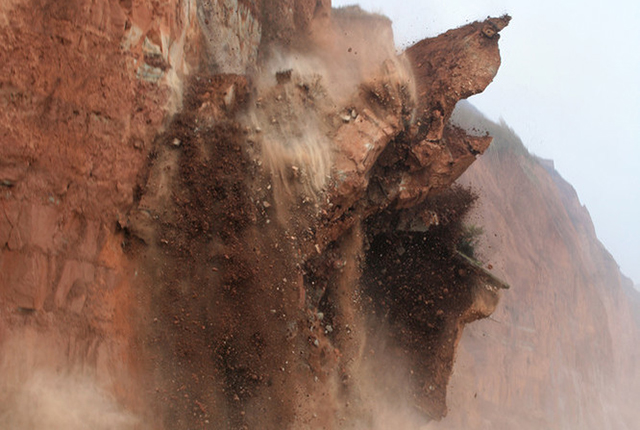
Landslide case studies
The landslides team at the BGS has studied numerous landslides. This work informs our geological maps, memoirs and sheet explanations and provides data for our National Landslide Database, which underpins much of our research.
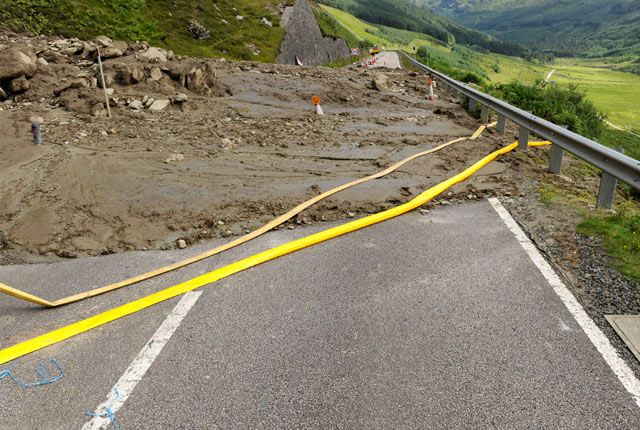
Understanding landslides
What is a landslide? Why do landslides happen? How to classify a landslide. Landslides in the UK and around the world.
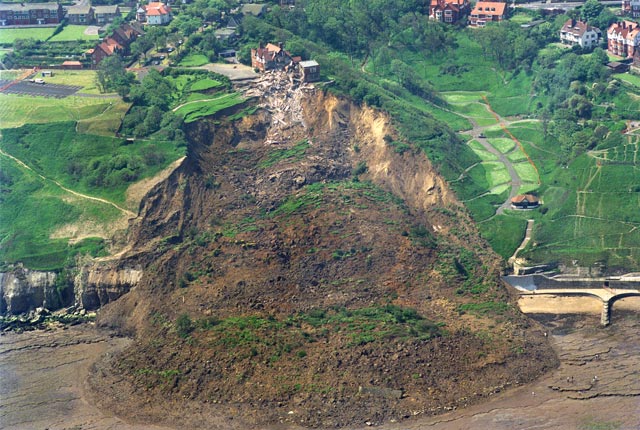
How to classify a landslide
Landslides are classified by their type of movement. The four main types of movement are falls, topples, slides and flows.
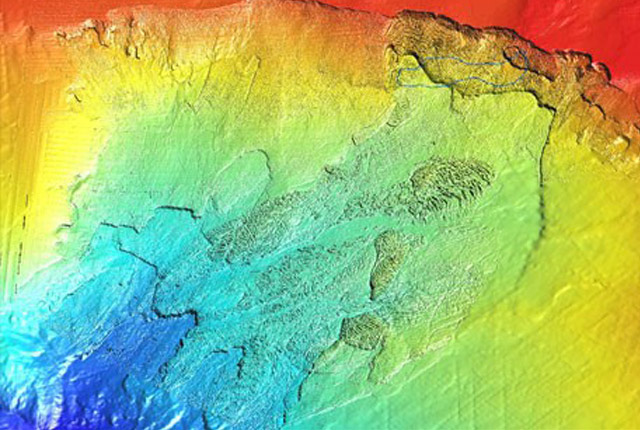
Landslides in the UK and around the world
Landslides in the UK, around the world and under the sea.


